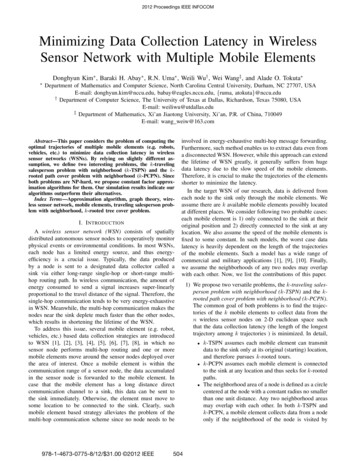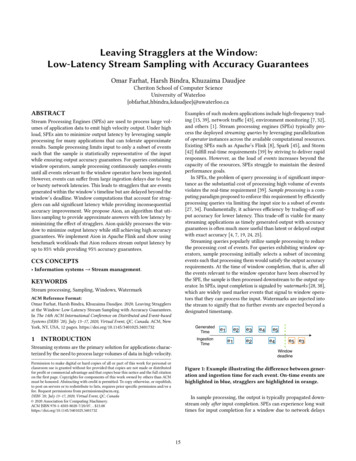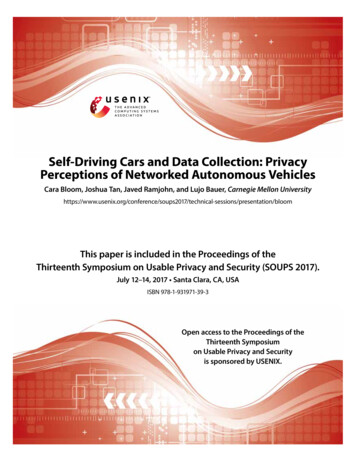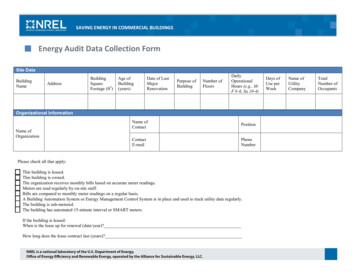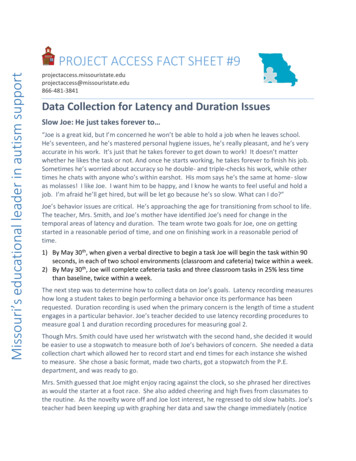
Transcription
Missouri’s educational leader in autism supportPROJECT ACCESS FACT SHEET souristate.edu866-481-3841Data Collection for Latency and Duration IssuesSlow Joe: He just takes forever to “Joe is a great kid, but I’m concerned he won’t be able to hold a job when he leaves school.He’s seventeen, and he’s mastered personal hygiene issues, he’s really pleasant, and he’s veryaccurate in his work. It’s just that he takes forever to get down to work! It doesn’t matterwhether he likes the task or not. And once he starts working, he takes forever to finish his job.Sometimes he’s worried about accuracy so he double- and triple-checks his work, while othertimes he chats with anyone who’s within earshot. His mom says he’s the same at home- slowas molasses! I like Joe. I want him to be happy, and I know he wants to feel useful and hold ajob. I’m afraid he’ll get hired, but will be let go because he’s so slow. What can I do?”Joe’s behavior issues are critical. He’s approaching the age for transitioning from school to life.The teacher, Mrs. Smith, and Joe’s mother have identified Joe’s need for change in thetemporal areas of latency and duration. The team wrote two goals for Joe, one on gettingstarted in a reasonable period of time, and one on finishing work in a reasonable period oftime.1) By May 30th, when given a verbal directive to begin a task Joe will begin the task within 90seconds, in each of two school environments (classroom and cafeteria) twice within a week.2) By May 30th, Joe will complete cafeteria tasks and three classroom tasks in 25% less timethan baseline, twice within a week.The next step was to determine how to collect data on Joe’s goals. Latency recording measureshow long a student takes to begin performing a behavior once its performance has beenrequested. Duration recording is used when the primary concern is the length of time a studentengages in a particular behavior. Joe’s teacher decided to use latency recording procedures tomeasure goal 1 and duration recording procedures for measuring goal 2.Though Mrs. Smith could have used her wristwatch with the second hand, she decided it wouldbe easier to use a stopwatch to measure both of Joe’s behaviors of concern. She needed a datacollection chart which allowed her to record start and end times for each instance she wishedto measure. She chose a basic format, made two charts, got a stopwatch from the P.E.department, and was ready to go.Mrs. Smith guessed that Joe might enjoy racing against the clock, so she phrased her directivesas would the starter at a foot race. She also added cheering and high fives from classmates tothe routine. As the novelty wore off and Joe lost interest, he regressed to old slow habits. Joe’steacher had been keeping up with graphing her data and saw the change immediately (notice
Missouri’s educational leader in autism supportthe vertical line on the graph.) She correctly revised strategies. She gave Joe a self-monitoringsheet and bought him an inexpensive stopwatch to time himself. This appeared to motivateJoe. He often told visitors that he was a “real fast starter” and showed off his data sheets. Heranalysis (graph) indicates that the intervention program was successful and is being maintainedover time.Knowing Joe, Mrs. Smith waited to begin intervention on goal 2 until Joe seemed to understandhis role in reaching goal1. Even so, Joe became confused, which contributed to the failure ofthe first strategy for both these goals. Mrs. Smith elected to suspend work on goal 2 for a while(see notation on graph).Because Joe proved to be motivated by using his stopwatch and self-monitoring sheet, Mrs.Smith decided to try these strategies to keep Joe working consistently until finished. She useddifferent colored self-monitoring sheets and a second stopwatch of a color which matched thesecond sheet to lessen Joe’s confusion (see notation on graph). Though Joe didn’t meet goal 2by May 30th, there was clear progress and the team felt Joe could master this goal during thenext school year. At the IEP meeting, Joe proudly showed the team his data sheets, saying heliked them and would “win the race” next year.
Missouri’s educational leader in autism support
Missouri’s educational leader in autism support
Missouri’s educational leader in autism support Project ACCESS - 2019 *Project ACCESS is a collaboration among the Missouri Department of Elementary andSecondary Education, Missouri State University, and Missouri’s public schools.
Data Collection for Latency and Duration Issues . Slow Joe: He just takes forever to “Joe is a great kid, but I’m concerned he won’t be able to hold a job when he leaves school. He’s seventeen, and he’s mastered personal hygiene issues, he’s really pleasant, and he’s very accurate in his work.
